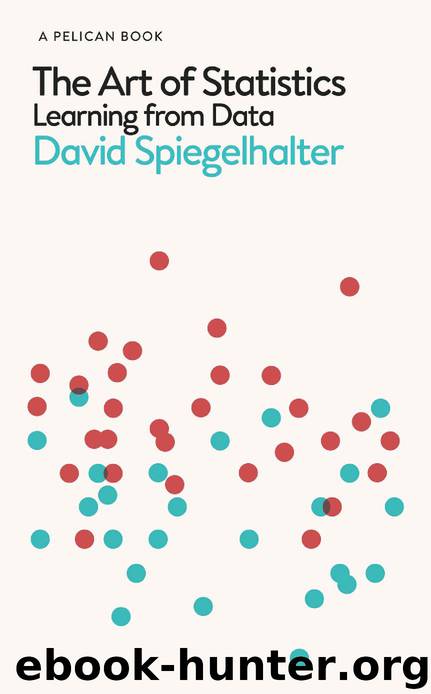The Art of Statistics: Learning From Data (Pelican Books) by David Spiegelhalter

Author:David Spiegelhalter [Spiegelhalter, David]
Language: eng
Format: epub
ISBN: 0241398630
Amazon: B07HQDJD99
Publisher: Pelican
Published: 2019-03-27T19:00:00+00:00
He was right – it really is an extraordinary law of nature.
How Does This Theory Help Us Work Out the Accuracy of Our Estimates?
All this theory is fine for proving things about distributions of statistics based on data drawn from known populations, but that is not what we are mostly interested in. We have to find a way of reversing the process: instead of going from known populations to saying something about possible samples, we need to go from a single sample back to saying something about a possible population. This is the process of inductive inference outlined in Chapter 3.
Suppose I have a coin, and I ask you for your probability that it will come up heads. You happily answer ‘50:50’, or similar. Then I flip it, cover up the result before either of us sees it, and again ask for your probability that it is heads. If you are typical of my experience, you may, after a pause, rather grudgingly say ‘50:50’. Then I take a quick look at the coin, without showing you, and repeat the question. Again, if you are like most people, you eventually mumble ‘50:50’.
This simple exercise reveals a major distinction between two types of uncertainty: what is known as aleatory uncertainty before I flip the coin – the ‘chance’ of an unpredictable event – and epistemic uncertainty after I flip the coin – an expression of our personal ignorance about an event that is fixed but unknown. The same difference exists between a lottery ticket (where the outcome depends on chance) and a scratch card (where the outcome is already decided, but you don’t know what it is).
Statistics are used when we have epistemic uncertainty about some quantity of the world. For example, we conduct a survey when we don’t know the true proportion in a population that consider themselves religious, or we run a pharmaceutical trial when we don’t know the true average effect of a drug. As we have seen, these fixed but unknown quantities are called parameters and are often given a Greek letter.fn4
Just like my coin-flipping example, before we do these experiments we have aleatory uncertainty about what the outcomes may be, because of the random sampling of individuals or the random allocation of patients to the drug or a dummy tablet. Then after we have done the study and got the data, we use this probability model to get a handle on our current epistemic uncertainty, just as you were eventually prepared to say ‘50:50’ about the covered-up coin. So probability theory, which tells us what to expect in the future, is used to tell us what we can learn from what we have observed in the past. This is the (rather remarkable) basis for statistical inference.
The procedure for deriving an uncertainty interval around our estimate, or equivalently a margin of error, is based on this fundamental idea. There are three stages:
We use probability theory to tell us, for any particular population parameter, an interval in which we expect the observed statistic to lie with 95% probability.
Download
This site does not store any files on its server. We only index and link to content provided by other sites. Please contact the content providers to delete copyright contents if any and email us, we'll remove relevant links or contents immediately.
| Biomathematics | Differential Equations |
| Game Theory | Graph Theory |
| Linear Programming | Probability & Statistics |
| Statistics | Stochastic Modeling |
| Vector Analysis |
Weapons of Math Destruction by Cathy O'Neil(5029)
Factfulness: Ten Reasons We're Wrong About the World – and Why Things Are Better Than You Think by Hans Rosling(4013)
Factfulness_Ten Reasons We're Wrong About the World_and Why Things Are Better Than You Think by Hans Rosling(2751)
Descartes' Error by Antonio Damasio(2728)
A Mind For Numbers: How to Excel at Math and Science (Even If You Flunked Algebra) by Barbara Oakley(2688)
TCP IP by Todd Lammle(2633)
Applied Predictive Modeling by Max Kuhn & Kjell Johnson(2474)
Fooled by Randomness: The Hidden Role of Chance in Life and in the Markets by Nassim Nicholas Taleb(2407)
The Book of Numbers by Peter Bentley(2399)
The Tyranny of Metrics by Jerry Z. Muller(2397)
The Great Unknown by Marcus du Sautoy(2179)
Once Upon an Algorithm by Martin Erwig(2141)
Easy Algebra Step-by-Step by Sandra Luna McCune(2110)
Practical Guide To Principal Component Methods in R (Multivariate Analysis Book 2) by Alboukadel Kassambara(2087)
Lady Luck by Kristen Ashley(2067)
Police Exams Prep 2018-2019 by Kaplan Test Prep(2028)
Linear Time-Invariant Systems, Behaviors and Modules by Ulrich Oberst & Martin Scheicher & Ingrid Scheicher(1980)
All Things Reconsidered by Bill Thompson III(1957)
Secrets of Creation, Volume 1: The Mystery of the Prime Numbers by Watkins Matthew(1858)
